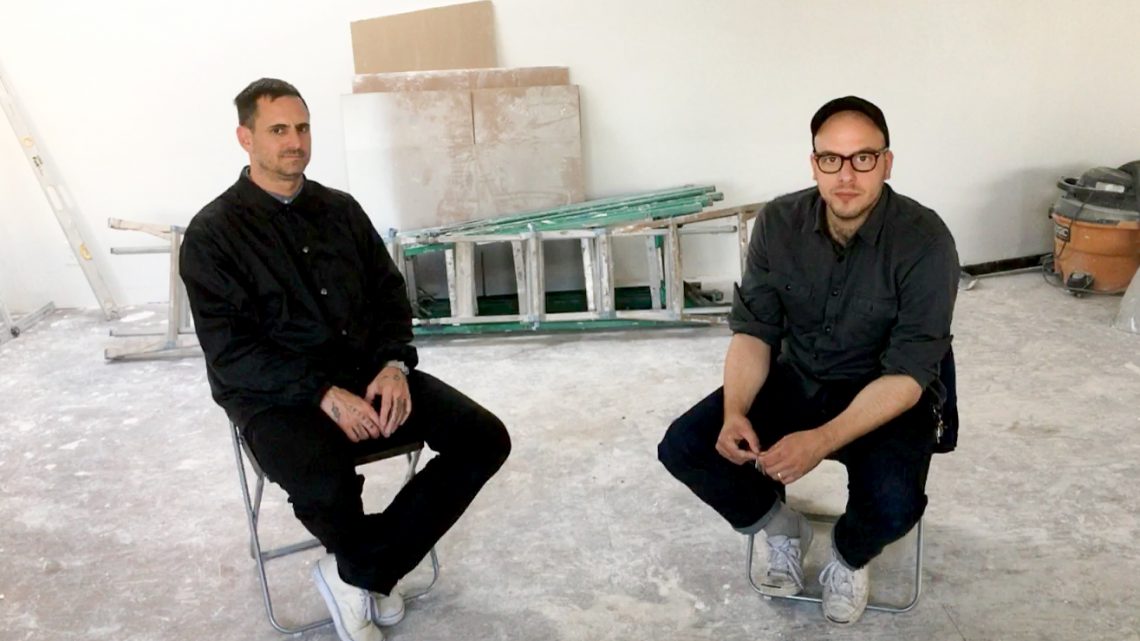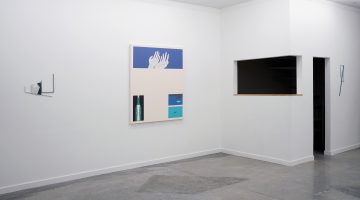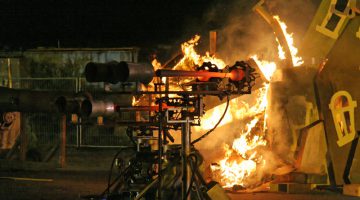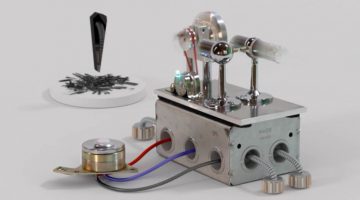CAPITAL was founded by Bob Linder and Jonathan Runcio in January 2015. Located in Chinatown in San Francisco, the space was notable for its small size, full front window, and tightly curated exhibitions that took advantage of the unique space constraints. Over the last two years they have curated exhibitions with numerous artists including Cynthia Daignault, Virginia Overton, Will Rogan, Davina Semo, Justin Morin, Kara Walker, and Sterling Ruby. In September 2016, I met them for an interview at their new, bigger space under construction in the Mission above Ratio 3. The space’s first show, a two-person exhibition with Justin Adian and Wendy White, opened in January 2017. We talked about why they originally founded CAPITAL, their approach to shows, and their goals for the new space. – J. D. McMillan
So I wanted to start at the beginning for you guys. How do you know each other?
Bob Linder: We know each other through the arts community here in San Francisco.
Jonathan Runcio: We officially met working at Ship/Art. Just a lot of mutual friends. Bob’s lived here a long time and I’ve lived here a long time.
BL: I think the Bay Area is a small arts community to begin with so people that seem to be motivated sort of rise up and those people get to know each other.
You guys did your first show at CAPITAL in January 2015. Tell me about the process of how you guys got to that point. Why did you found CAPITAL? What were your goals for the space?
BL: Jonathan and I were DJing an evening at a bar here. The evening was a creative sort of DJ night where we were trying to do events, show videos—things with performative aspects. And through that evening we started having these conversations and thinking we should get a garage or a space to host the events outside of the bar. And then slowly through those conversations it started becoming much more of a curatorial kind of idea and we started hunting for spaces.
JR: And Chinatown was really the only neighborhood that we could afford at the time. We looked in the Mission. We looked everywhere and this space became available and it was the full front window that was really appealing.
Did you guys have any specific goals that you agreed on together or anything like that? Or was it more informal at the beginning that you knew wanted to share some kind of curatorial vision?
JR: I think for us the goal was to show artists we thought were interesting, work that was not always shown in the Bay Area. That’s what I felt like we were trying to do.
BL: I think from the beginning we were both interested in non-regional artists for the most part.
How did you guys land on the name CAPITAL in all caps with the strikethrough?
JR: I think there was a lot of talk about economic and venture capital at the time—San Francisco being low on its cultural capital and all that. Also because we had no money and a lot the rental agencies and spaces that we looked at asked us if we had capital. Since we had no money we just drew a line through the word, a strikethrough. That’s the basic origin of the name. We wanted something open that could have a lot of meanings and we didn’t want it to be our last names.
BL: Something that struck a resonance with what was happening in San Francisco during that time—the “changing” of the city.
JR: Yeah, everyone was talking about how much money was flooding into the city. So it seemed like a way to spin it.
The Chinatown space that you guys chose is super unique. You already described it a little bit, but I was wondering if you could dive a little deeper about what attracted you to the space.
JR: I mean it was in our budget, which was the #1 reason.
It was very low overhead. It was 12 x 12 feet and it has a full front window.
BL: Yeah, ground floor, beautiful, large window. It seemed like that was it—it made a lot of sense. We can’t be there all the time so when CAPITAL is not open you can still see the show. That was an appealing aspect of that space.
JR: It’s basically a floor to ceiling window so it makes the whole gallery seem like a vitrine.
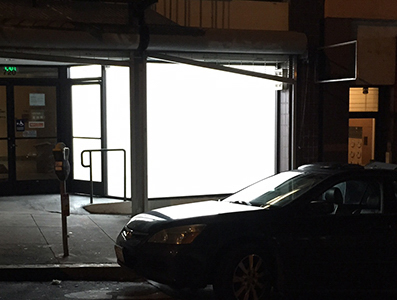
Street view of gallery window at original 716 Sacramento Street location. Courtesy of CAPITAL.
In your first show Touch the Spindle the works and the installation filled the space in a way that I think really took advantage of the unique characteristics of that space.
JR: It was great the way it highlighted the space because you had a mobile by Will Rogan just floating in space but then you had the Virginia Overton covered fluorescent light bulbs. It really made the space feel like part of the show.
BL: I think it framed the idea of what kind of exhibitions we wanted to have.
JR: For me—it was sort of like “Oh, this space has amazing potential.” You know what I mean? That show really proved it to me—it’s a space that can pull its own weight.

Virginia Overton, Untitled, 2015. Duratrans, bulb guards, fluorescent bulbs, and fixtures, dimensions variable. Courtesy of CAPITAL.
I was wondering if you guys could talk a little bit more about how that space influenced your approach to shows.
JR: I mean there’s an economy that happens when you can only show three paintings or when you can only show one mural or one video. It makes it—I don’t want to say simple because it’s almost harder to minimize and to edit a show down to just three walls. But in the end the artists are creating work for the space, which is something I didn’t anticipate happening and is a nice byproduct of having that space. Cheyney Thompson made a mural for the back wall and Sterling Ruby made a sculpture the height of the gallery ceiling which was pretty unexpected. We just kind of went with the space we could afford and a size that was interesting. But then it generated all this good work.
Has that been the case for most shows where artists are really making work specifically for the space?
BL: I think for the most part. Steve Lichty did. Cheyney did. Justin Morin. Even Davina Semo made work specifically for CAPITAL. Most everyone really took the measurements of that space in mind and the window in mind.
JR: Yeah, and the way art is viewed through the window. The scale.

Installation View, Flex, Justin Morin at CAPITAL, San Francisco, 2016. Courtesy of CAPITAL.
The artists you’ve chosen to show come from a variety of places. Some of them do have a connection to the Bay Area, but you’ve also shown a number of artists from New York, Los Angeles, and Europe. You’ve also recently shown some bigger names like Kara Walker and Sterling Ruby. So I was wondering, what’s your approach to the artists that you choose to work with?
BL: I think we come at it from a point of view of artists and work that we really like—that’s ultimately it. Things that we look at, things that we continue to carry through conversation.
JR: Yeah, I mean we talk about it all the time. You know, doing the DJ night you talk. You’re playing a record and you’re talking. We’re meeting for beers or at work you cross paths and have this conversation. And some of the names that would come up were like Sterling Ruby—”Oh, did you see that Sterling Ruby piece?”
BL: The Sterling Ruby piece, that took about a year and a half to happen. It took that long for it to work itself out into the exhibition that it became. But you know we just made a notch of somebody that we were interested in and we just kept cycling it through until we figured where and how it would it work.
You also said non-regional artists. Could you expand a little bit on that? Has that been a specific thing that you felt like there was a gap somewhere in the art spaces in San Francisco that you were looking to fill?
BL: I feel like there are already a fair number of galleries here that want to show regional artists, spaces that do a good job showing up-and-coming people from the Bay Area. But you know San Francisco is rife with opportunity for people that are in other places who want to show here. That’s actually pretty exciting to me, the opportunity to craft relationships with these artists.
JR: Yeah, and then there are always these weird connections that artists do have with the Bay Area. Kara Walker, who was in our spring show, is from the Bay Area. A lot of people are connected to the Bay Area and it’s just about teasing out those connections and folding them back in.
BL: Will [Rogan] was in Touch the Spindle. We were conscious about that. We did want to have somebody from the Bay Area open the first show. We thought it was important.
JR: Yeah, and then Cynthia Daignault was also in that show. She was New York-based at the time, but she went to Stanford for undergrad so she has a Bay Area connection.
You guys don’t have a roster of artists that you represent. Was that an intentional decision and do you have any plans to start representing artists?
BL: I think we both felt like it made it a little freer for us to make decisions.
JR: Also, I think representing an artist requires resources that we didn’t know if we would have starting out. If we represented an artist I would want to do it right. I’d want to be able to provide all the things that a gallery should be providing on that side of the relationship.
BL: We’ve done a pretty good job of just maintaining good relationships with artists that want to keep working with us. I feel the best about that. It seems a little more exciting than having a roster of fifteen people on it.
JR: Yeah, I feel like when it comes time to do it the artists will definitely be 100% on board. You’re building a relationship—it’s not going to happen right away. So that’s been a nice thing—building these partnerships with artists.
You guys have been doing CAPITAL for almost two years. In addition to the shows you’ve had at the Chinatown space you’ve also done NADA Miami Beach and you’ve done something at the Minnesota Street Project. What are your goals with those types of shows that you are putting together?
BL: I was excited about Minnesota Street because it was a larger space to deal with. It’s a little more of a challenge now to try to put together something large. For instance Phil Wagner, who was in the Minnesota Street exhibition—we wanted to do something with Phil for a long time. This gave us the opportunity to actually show these large paintings of Phil’s that we never could show at CAPITAL at that time.
JR: They wouldn’t physically fit in the space.
BL: Also Survival Research Laboratories—it gave us the opportunity to finally do a studio visit with Mark Pauline and see if we could present an SRL machine, which we also could not do at CAPITAL, the Chinatown space. And again we were able to open up more relationships with people that we hoped to work with in the future.

Installation view, BLACK STANDARD at the Minnesota Street Project, San Francisco, 2016. Courtesy of CAPITAL.

Survival Research Laboratories, Running Machine, 1992. 96 x 70 x 144 inches (resting). Courtesy of CAPITAL.
And how has the art fair experience been for you guys?
JR: It’s been good. I mean it’s just about making connections—other artists, other gallerists, and curators.
BL: We did NADA Miami Beach last year and it might not have been the most economically successful, but ultimately we came out of it feeling like it was really a great thing to do. The connections that were made—we couldn’t have gotten that otherwise.
JR: This goes hand in hand with our programming to this point. Because we don’t always show local artists I think we do have to play a role in this bigger scene. It’s really essential to us being in San Francisco to be out there.
You guys will be opening your new space in the Mission in January 2017 above Ratio 3. How did you guys end up in this new space and did you consider other spaces around town?
JR: We weren’t looking for a space because we have some time on our lease in Chinatown still. This was something that was presented to us—we were not pursuing this space in particular. And I’ve had a relationship with Chris Perez, the director and owner of Ratio 3, for almost 20 years now. I think he respects what we do, and we obviously respect what he does. He just had the space and I think, you know, he wants to have some dialogue or some art neighbors. Because he also notices what’s happening to the city and he wants to take back the Mission. I mean the Mission used to be a very creative place, for music, for art—it used to be a great hub. I think it’s lost a little bit of that and I think he’s trying to bring it back a little bit.
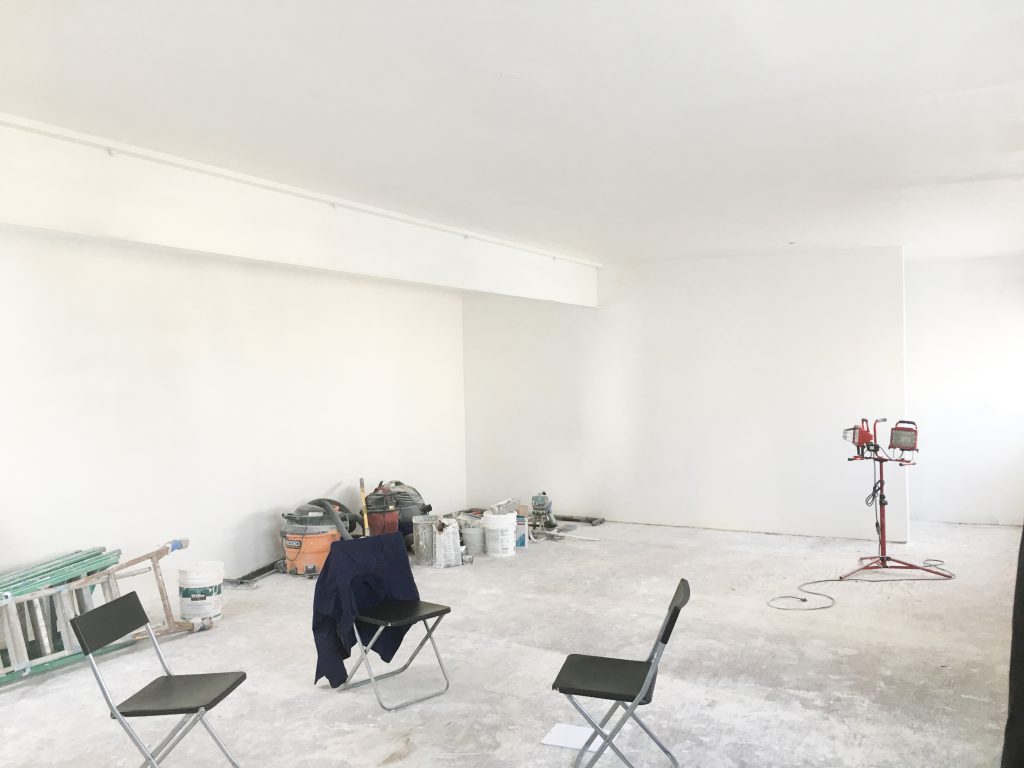
Buildout of new 26 Lilac Street location. Photograph by J. D. McMillan. Courtesy of J. D. McMillan and CAPITAL.
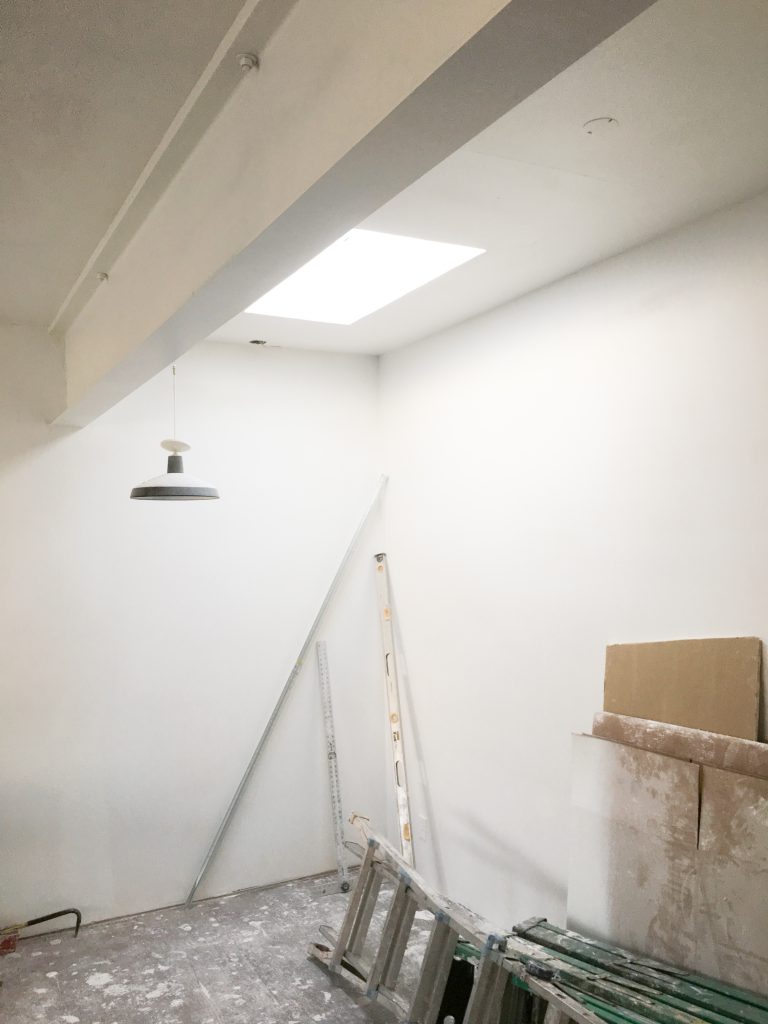
Buildout of new 26 Lilac Street location. Photograph by J. D. McMillan. Courtesy of J. D. McMillan and CAPITAL.
The new space is significantly bigger than your current space, which offers different opportunities for you guys. Why did you guys decide to move and what are your goals for the new space?
JR: It is an opportunity that we couldn’t pass up. I think that’s why we’re doing it when we’re doing it.
BL: This also gives us the opportunity to be open more—to spend more time at the gallery.
JR: The visibility is higher in this neighborhood as well. A lot of people wouldn’t go all the way to Chinatown to see our little space but maybe they’ll come to the Mission to see a bigger space.
BL: Also, after two years we did realize that there are certain things, if we would like the project to extend into the future, we really do need a few things—the viewing room is going to be essential and having a reception office area is important. But one of the things that I love and artists love about CAPITAL is that there’s nothing in there. The Chinatown space, it’s nothing but exhibition space. There’s no desk, there’s nothing to get in the way of the work. We’ve have been trying to treat this new location with a similar kind of respect. The exhibition space that we are sitting in right now will just be the work.
What does success look like for you guys for this space?
JR: Just building more relationships and solidifying the relationships that we have. We are talking about starting a roster now because we’re able to offer a lot more space and more resources. So I don’t know, I think success would be having great shows happen—having the shows meet the scale of the new space.
BL: I think success would be if some of the artists that we’ve been working with—Rainen Knecht, Todd Bura, Justin Morin—if we could cultivate relationships with other galleries and start showing them outside of the Bay Area. I really feel like that would be a sign of success for the gallery. Already people take it seriously outside of the Bay Area, but it would nice for those artists to start showing in places that we care about as well.
Anything else you wanted to add?
BL: I’m excited about phase two of this gallery. Taking on the new location ups everything that we have to pay and that’s something that we have to consider. Now we have to really think about making sales like we never had before.
JR: But we’re in a position too, where if we don’t sell anything, we can still cover costs. So it’s not mandatory.
BL: I guess in a fun way you could think of this as exactly like the little space. It’s still manageable. We actually didn’t go out of our way to do something that we couldn’t control. And I think that’s been important. Just like not taking on a roster, it’s been important for us to be responsible.
JR: Yeah, I don’t know, I think we were ready for something—the next step—we just didn’t know what it would be. We thought we needed a space but then you know the real estate climate in the city. I was almost dreading next year because after the next year in Chinatown we’d have to start looking for a bigger space. That seemed like a nightmare. But this opportunity opened up, so let’s just walk through the door and see what happens.

Installation view, Gypsy Wagon, Jason Adian and Wendy White at CAPITAL (new 26 Lilac Street location), San Francisco, 2017. Courtesy of CAPITAL. Gypsy Wagon is now on view through February 25.
